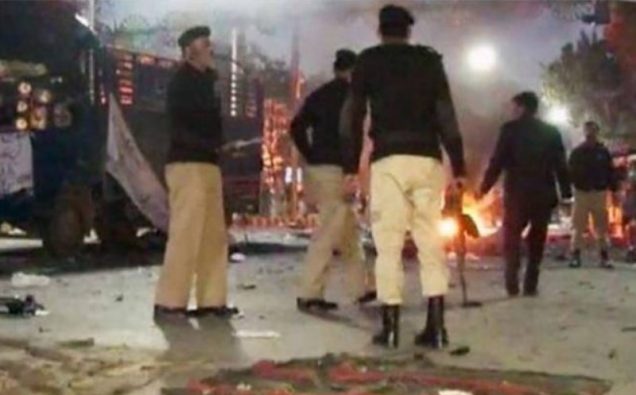
At least 13 people perished on Monday in the heart of Pakistan when a suicide bomber blew himself up in the middle of a protest rally outside Punjab Assembly in Lahore.
The victims included Deputy Inspector General Police Traffic, Capt (rtd) Ahmad Mobeen and Senior Superintendent Police, Lahore, Zahid Gondal.
According to officials, a high-intensity explosion rocked the area at 6:10 pm at Charing Cross on Lahore’s Mall Road – the site of a protest, where negotiations were going on between protesting pharmacists and the DIG Traffic Lahore.
This was the deadliest blast in Lahore after Easter Day bombing in 2015 that had left more than 70 people in Gulshan-e-Iqbal public park. This time too, terrorist organization, Jamat-ul-Ahrar, a faction of the Tehrik-e-Taliban Pakistan (TTP) has taken responsibility.
However, security analysts suspect a string of bomb blasts that rocked Lahore, Quetta and tribal areas on Monday, could be the handiwork of regional countries upset by Pakistan’s economic rise. Pakistan has tense relations with both India and Afghanistan. In a sign of tensions on Pakistan’s eastern border, Indian shelling killed three Pakistani soldiers in the disputed Kashmir region.
In the last few months, Pakistan has been hitting headlines as a destination for foreign investments after reforms and Chinese heavy investment in projects under China Pakistan Economic Corridor have boosted economic activity and opened new opportunities in energy, infrastructure, industrial and services sectors.
Analysts also say the Lahore bombing on Monday could also have been timed to keep the foreign cricket players away from the finals of Pakistan Super League tournament, scheduled to be held in Lahore next month.
Soon after the blast, Police called it a planted bomb but later law enforcement officials confirmed it to be a suicide bombing.
“Apparently it was a suicide blast, but police are still investigating to know the exact nature of blast,” a Punjab police spokesperson said.
“The bomber came on a motorbike and detonated his suicide vest (while the protesting pharmacists were dancing after their successful negotiations with the DIG Traffic),” another police official said.
A spokesperson for the Punjab government, later in the evening, confirmed it was a suicide bombing.
Although security on Mall Road had been heightened in view of the protest by the Pakistan Chemists and Pharmaceuticals Manufacturers against the new Act on drugs, the provincial metropolis had been on the list of an unidentified terrorist group according to an intelligence report dated February 7.
Immediately after the bombing, rescue officials reached the crime spot – where a significant number of law enforcers had already been present due to the protest – and ferried the injured to Sir Ganga Ram and Mayo hospitals, where the condition of more than 20 injured was stated to be critical. A state of emergency was declared in all hospitals across Lahore.
Contingents of Army and Rangers were also called in as the area was cordoned off with tents. The inner cordon was taken over by army personnel, while the outer one by the paramilitary Rangers and police. Two suspects were arrested from the blast site by Rangers officials and later handed over to police for questioning.
The explosion was so powerful that it rocked the entire area, and shattered windowpanes of nearby buildings, residents and visitors said.
“Suddenly there was a bang and a huge blast,” said a traffic officer on the scene, adding, “The explosion was caused when a man riding a motorcycle collided with a vehicle.
“Everybody ran for safety.”
















